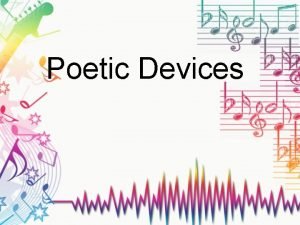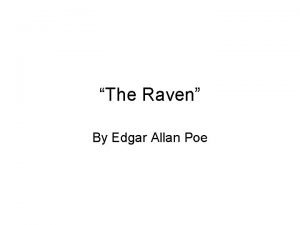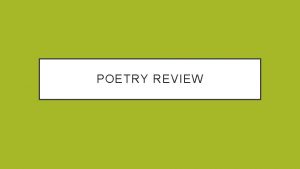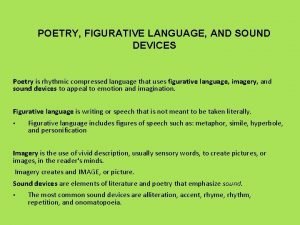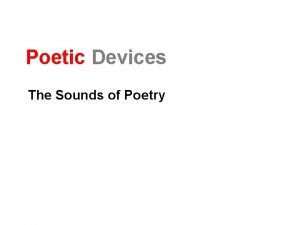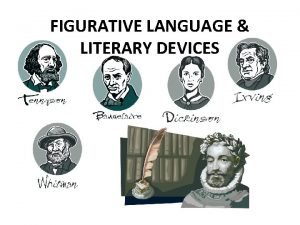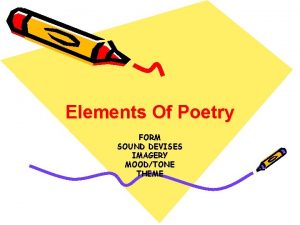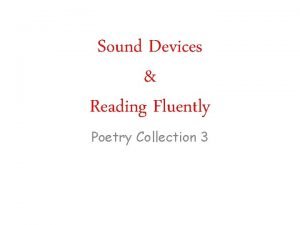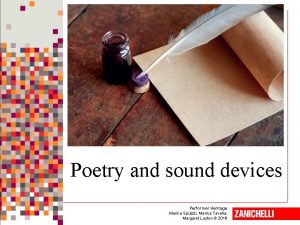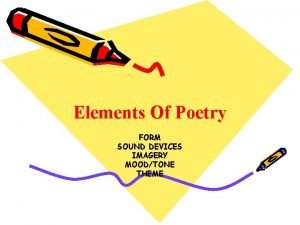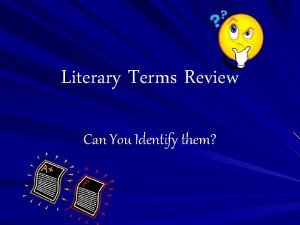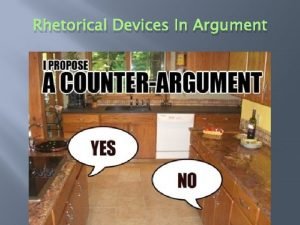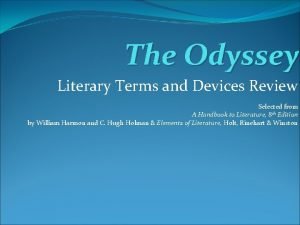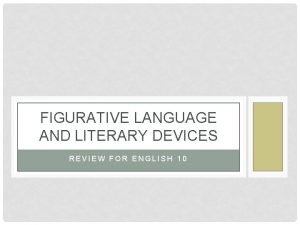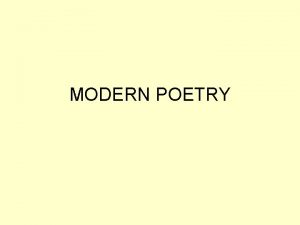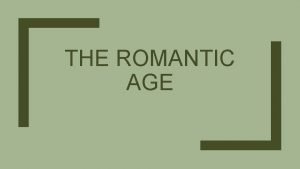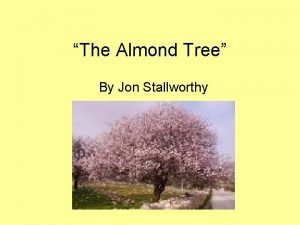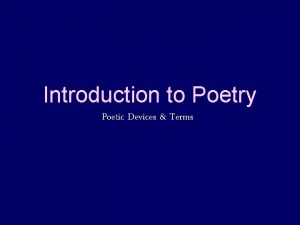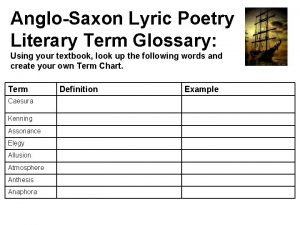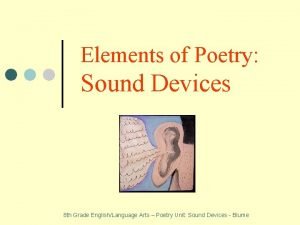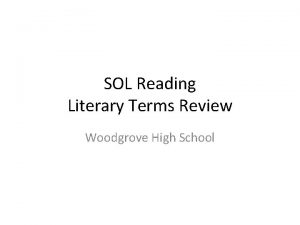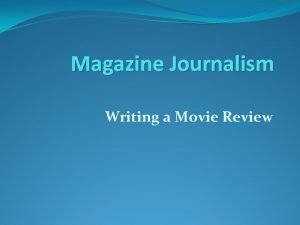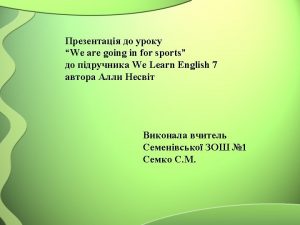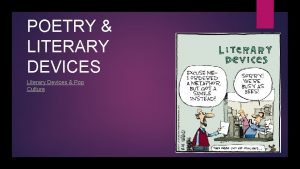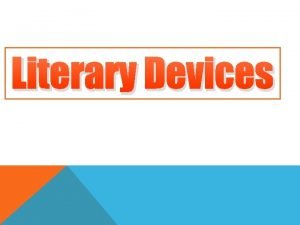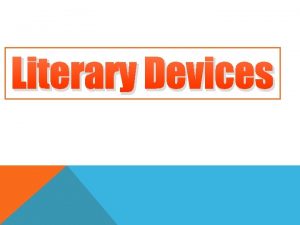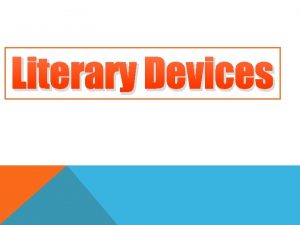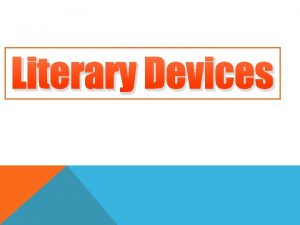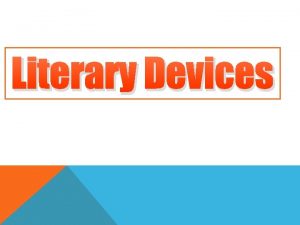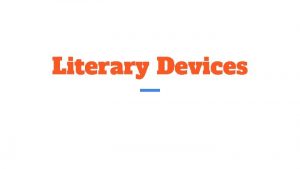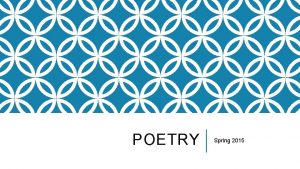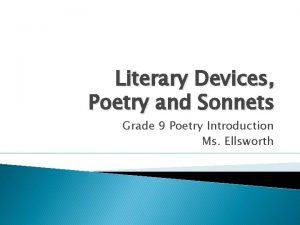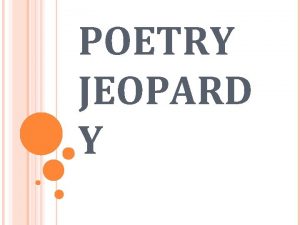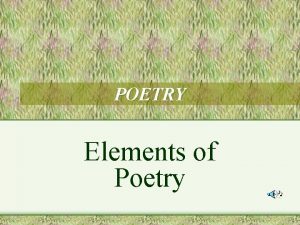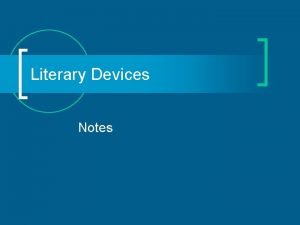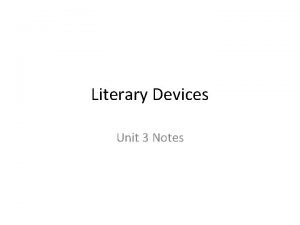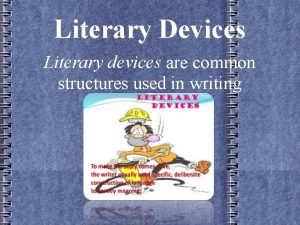POETRY REVIEW LITERARY DEVICES Sound Devices SOUND DEVICES



























![PETRARCHAN SONNET FORM Octave: abba [introduces problem/desire] Sestet: cdecde or cdcdcd [comments/provides solution] PETRARCHAN SONNET FORM Octave: abba [introduces problem/desire] Sestet: cdecde or cdcdcd [comments/provides solution]](https://slidetodoc.com/presentation_image_h/982926c7de614bb1b4713e45e7b0590c/image-28.jpg)

![SHAKESPEAREAN SONNET FORM Quatrain 1: abab [introduces question] Quatrain 2: cdcd [tentative answers] Quatrain SHAKESPEAREAN SONNET FORM Quatrain 1: abab [introduces question] Quatrain 2: cdcd [tentative answers] Quatrain](https://slidetodoc.com/presentation_image_h/982926c7de614bb1b4713e45e7b0590c/image-30.jpg)



- Slides: 33

POETRY REVIEW

LITERARY DEVICES Sound Devices

SOUND DEVICES Rhythm: The beat created by the sounds of the words in a poem. • Let’s first break down the poetry devices into different categories. The easiest way to begin is with sound devices. • Which terms help us focus on the sounds of the poem? ØAlliteration, assonance, consonance, end rhyme, internal rhyme, near/slant rhyme

SOUND DEVICES • Alliteration is a stylistic device in which a number of words, having the same first consonant sound, occur close together in a series. • Assonance: takes place when two or more words close to one another repeat the same vowel sound but start with different consonant sounds. • Consonance: Similar to alliteration EXCEPT: repeated consonant sounds can be anywhere in the words, not just at the beginning.

“The Raven” by Edgar Allan Poe 1 Open here I flung the shutter, when, with many a flirt and flutter, In there stepped a stately Raven of the saintly days of yore; Not the least obeisance made he; not a minute stopped or stayed he; But, with mien of lord or lady, perched above my chamber door— 5 Perched upon a bust of Pallas just above my chamber door— Perched, and sat, and nothing more. How is alliteration different from consonance? Where can we see examples of alliteration in the stanza above? How about consonance? Assonance?

TERMS: SOUND DEVICES (RHYME) • Internal Rhyme: metrical lines in which its middle words and its end words rhymes with each other • Example: Once upon a midnight dreary, while I pondered weak and weary • End rhyme is defined as when a poem has lines ending with words that sound the same. • Slant Rhyme/Near Rhyme: It can be defined as a rhyme in which the stressed syllables of ending consonants match, however the preceding vowel sounds do not match.

I heard a Fly buzz - when I died The Stillness in the Room Was like the Stillness in the Air Between the Heaves of Storm How is slant/near rhyme different from perfect rhyme? What is an example of slant rhyme in the stanza above? What is the simile in the above stanza? Explain the significance of the comparison.

TERMS: SOUND DEVICES (RHYME) • How do we visualize the patterns of rhyme in a poem? • Rhyme Scheme: Use the letters of the alphabet to represent sounds to be able to visually “see” the pattern Once upon a midnight dreary, while I pondered, weak and A weary, B Over many a quaint and curious volume of forgotten lore— C While I nodded, nearly napping, suddenly there came a B tapping, B As of some one gently rapping, rapping at my chamber door. B “’Tis some visitor, ” I muttered, “tapping at my chamber door—

FIGURATIVE LANGUAGE

FIGURATIVE LANGUAGE • Connotation refers to a meaning that is implied by a word apart from the thing which it describes explicitly. • Example: Pushy versus Assertive • Denotation is generally defined as literal or dictionary meanings of a word

FIGURATIVE LANGUAGE • Allusion: A reference to someone or something famous. • Hyperbole: An intentional exaggeration or overstatement, often used for emphasis • Imagery: Language that provides a sensory experience using sight, sound, smell, touch, taste • Oxymoron: Combines two usually contradictory terms in a compressed paradox, as in the word bittersweet or the phrase living death • Personification: A nonliving thing given human or life-like

TERMS: COMPARISONS • Metaphor: a figure of speech which makes an implicit, implied or hidden comparison between two things that are unrelated but share some common characteristics. • Example: This assignment was a breeze. • Simile: Comparison of two unlike things using “like” or “as” • Extended Metaphor: a metaphor that continues for several lines or possibly the entire length of a work

TERMS: TONE VS. MOOD • Tone: Used in poetry to convey feeling and emotion. Often thought of as the attitude of the speaker. • Mood: The atmosphere of the poem, often created through the description of setting.

LITERARY DEVICES FORM AND METER

METER Rhythm can also be created using meter. What is meter? Meter: A pattern of stressed (strong) and unstressed (weak) syllables

IAMBS • Each unit or part of the pattern is called a “foot. ” We focused on one type: iambs. • Iambs: an unstressed syllable followed by a stressed syllable. • What different types of iambic meter have we focused on in class?

IAMBIC METER Iambic Trimeter: Divided into three iambs (6 syllables) Iambic Tetrameter: Divided into four iambs (8 syllables) Iambic Pentameter is when a line of poetry is divided into 5 iambs (10 syllables).

IAMBIC METER & POETS • Dickinson often used iambic tetrameter and iambic trimeter in her poems. • Shakespeare LOVED to write using iambic pentameter. • Poe used trochaic octameter in “The Raven” but that’s not important.

SYNTAX (SENTENCE STRUCTURE)

SYNTAX • Anaphora: The repetition of the first part of the sentence or phrase. • Asyndeton: The intentional exclusion of conjunctions. • Polysyndeton: The intentional inclusion of conjunctions. • Enjambment: When a line of poetry doesn’t end with punctuation, but continues on to the next line.

TYPES OF POETRY

TYPES OF POETRY • Narrative • Shakespearean Sonnet • A type of poem that follows a storyline and has a plot • 14 line poem broken into 4 parts; written in iambic pentameter • Ballad Meter • Alternating lines of iambic tetrameter and trimeter with ABCB rhyme scheme • Petrarchan Sonnet • Also known as Italian Sonnets, 14 lines broken into 2 parts

TYPES OF POETRY • Lyrical Poetry • Blank Verse • Short poem (only a few lines, 12 stanzas) • Usually written in first person point of view • Expresses an emotion or an idea, or describes a scene • Does not tell a story and are often musical • Does have a regular meter, usually iambic pentameter (five sets of stressed/unstressed) • Does NOT have rhyme • Used by classical playwrights, like Shakespeare

PARTS OF POETRY

PARTS OF POETRY There are many parts to each poem. What are some words that help us identify the different parts of a poem? Couplet Octave Quatrain Sestet Stanza

PARTS OF POETRY • How are poems usually arranged? • By stanzas of course! • Stanza: A group of lines arranged together • Couplet: Two lines in a row that have an end rhyme and the same meter. These are often found at the end of which type of poetry? • Sonnets! ababcdcdefefgg

PARTS OF POETRY Octave: A stanza of 8 lines What is the rhyme scheme of octaves in Petrarchan Sonnets? Rhyme scheme of abba Sestet: A stanza of 6 lines What is the rhyme scheme of sestets in Petrarchan Sonnets? Rhyme scheme of cdecde or cdcdcd
![PETRARCHAN SONNET FORM Octave abba introduces problemdesire Sestet cdecde or cdcdcd commentsprovides solution PETRARCHAN SONNET FORM Octave: abba [introduces problem/desire] Sestet: cdecde or cdcdcd [comments/provides solution]](https://slidetodoc.com/presentation_image_h/982926c7de614bb1b4713e45e7b0590c/image-28.jpg)
PETRARCHAN SONNET FORM Octave: abba [introduces problem/desire] Sestet: cdecde or cdcdcd [comments/provides solution]

PARTS OF POETRY • Quatrain: Stanza or short poem containing four lines • Lines 2 and 4 must rhyme, while lines 1 and 3 may or may not rhyme • Variations in rhyming patterns (abab, abcb) Volta: The turn or transition in line 9 of sonnets which marks a shift in focus or thought How are Shakespearean Sonnets organized? How many quatrains are there?
![SHAKESPEAREAN SONNET FORM Quatrain 1 abab introduces question Quatrain 2 cdcd tentative answers Quatrain SHAKESPEAREAN SONNET FORM Quatrain 1: abab [introduces question] Quatrain 2: cdcd [tentative answers] Quatrain](https://slidetodoc.com/presentation_image_h/982926c7de614bb1b4713e45e7b0590c/image-30.jpg)
SHAKESPEAREAN SONNET FORM Quatrain 1: abab [introduces question] Quatrain 2: cdcd [tentative answers] Quatrain 3: efef [tentative answers] Rhyming Couplet: gg [final answer]

Sonnet 29 When, in disgrace with fortune and men's eyes, I all alone beweep my outcast state, And trouble deaf heaven with my bootless cries, And look upon myself, and curse my fate, Wishing me like to one more rich in hope, Featur'd like him, like him with friends possess'd, Desiring this man's art and that man's scope, With what I most enjoy contented least; Yet in these thoughts myself almost despising, Haply I think on thee, and then my state, Like to the lark at break of day arising From sullen earth, sings hymns at heaven's gate; For thy sweet love remember'd such wealth brings That then I scorn to change my state with kings. Identify: Quatrain Volta Couplet

POETS

POETIC STYLE • Dickinson: Dashes, slant rhyme (assonance), metaphors, common themes of death and nature, unique capitalization • Poe: Alliteration, rhyme (end and internal), gloomy mood, topic usually revolved around death and beautiful women • Shakespeare: Wrote during
 Literary devices in introduction to poetry by billy collins
Literary devices in introduction to poetry by billy collins The raven by edgar allan poe rhyme scheme
The raven by edgar allan poe rhyme scheme Rhyme sound device
Rhyme sound device Poetic devices and figurative language
Poetic devices and figurative language Drip hiss the rain never stops
Drip hiss the rain never stops What are sound devices in a poem
What are sound devices in a poem Sound devices in a poem
Sound devices in a poem Sound devices definition poetry
Sound devices definition poetry Poetry and sound devices zanichelli
Poetry and sound devices zanichelli Elements of poem writing
Elements of poem writing What are some literary devices
What are some literary devices Pathetic fallacy vs personification
Pathetic fallacy vs personification Literary devices in the sound of waves
Literary devices in the sound of waves The odyssey literary devices
The odyssey literary devices Repetition figure of speech examples
Repetition figure of speech examples Literary elements and techniques
Literary elements and techniques Literary devices review
Literary devices review Neoclassical and romantic poetry
Neoclassical and romantic poetry Traditional poetry vs modern poetry
Traditional poetry vs modern poetry Non narrative poems
Non narrative poems Augustan poetry aim
Augustan poetry aim Poetry poetry
Poetry poetry Moods of a poem
Moods of a poem Poetic device
Poetic device Lyric literature
Lyric literature Literary genres
Literary genres Which poetry element affects the poem's sound?
Which poetry element affects the poem's sound? Be darwin in your patience poetic device
Be darwin in your patience poetic device Literary elements review
Literary elements review Movie review informative journalistic literary
Movie review informative journalistic literary Literary terms review game
Literary terms review game “a sound mind is in a sound body”
“a sound mind is in a sound body” Sound waves graphic organizer
Sound waves graphic organizer Chapter review motion part a vocabulary review answer key
Chapter review motion part a vocabulary review answer key
